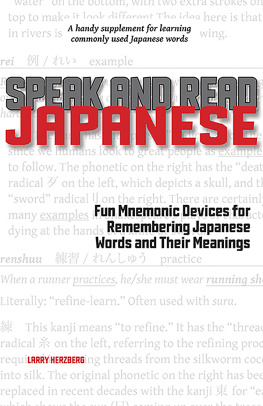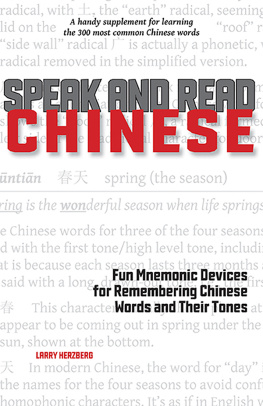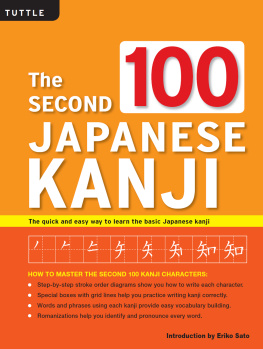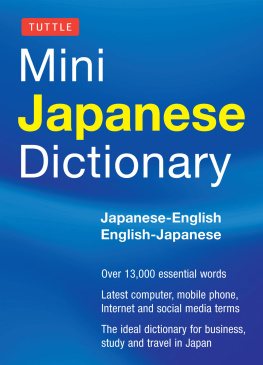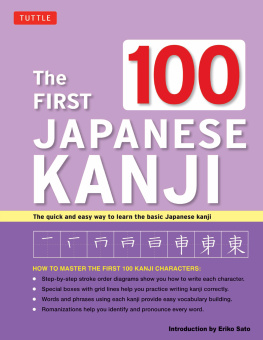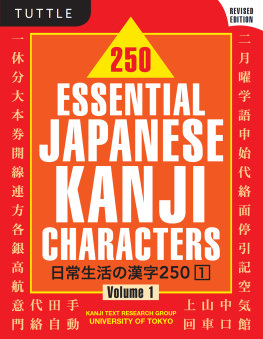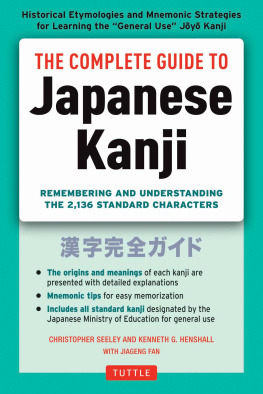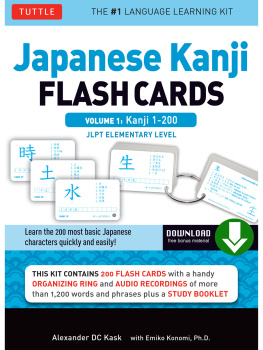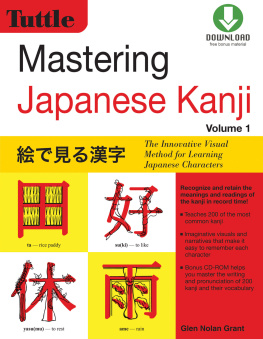
Fun Mnemonic Devices for Remembering Japanese Words and Their Meanings
Larry Herzberg
Stone Bridge Press Berkeley, California
Published by
Stone Bridge Press
P. O. Box 8208, Berkeley, CA 94707
TEL 510-524-8732
2017 Larry Herzberg.
First printing, 2017.
All rights reserved.
No part of this book may be reproduced in any form without permission from the publisher.
Printed in the United States of America.
p-ISBN 978-1-61172-040-2
e-ISBN 978-1-61172-928-3
PREFACE
In studying eight foreign languages over many decades, I discovered that the best way for me to learn new vocabulary in those languages was to think of mnemonic devices, i.e., memory hooks, for each word. If I could relate the sound or meaning of a word I was trying to learn to a word in English, I had a much better chance of cementing that word in my memory.
Using mnemonic devicesor mnemonicsto learn new vocabulary is not so crucial for an English speaker trying to learn a Romance language, given that 60 percent of words in French, Spanish, and Italian have English-language cognates. However, in a language as different from English as Japanese, having clever ways to jog your memory is most helpful when trying to learn new vocabulary.
When I was first learning Japanese, it helped me to remember the phrase for youre welcome, doo itashimashite, by thinking dont touch my mustache. It was also easy to remember the word anata (you) by creating my own memory hook of therell never be anata (another) you. And the Japanese verb ikimasu (to go) was much easier to recall if I thought about going anywhere in winter in a northern clime being an icky mess.
I dont have particularly catchy memory hooks for every single word in Japanese. And even if I did, I could never fit them all into this book. What I have done here instead is provide mnemonics for almost three hundred commonly used Japanese words that all students learn in the first year or two of studying Japanese. I hope that these will encourage you to think of your own mnemonics for the words I do not include.
I taught Japanese at the college level for over twenty years. When some years ago I anonymously surveyed nearly a hundred of my Japanese-language students as to how helpful they thought my mnemonics were, nearly all of them answered that they found them either very helpful or somewhat helpful. Only one student responded that he/she found them slightly annoying. I have, therefore, continued to use them in my teaching and hope to share them with a wider audience.
I do want to share a few words of caution about using mnemonic devices to remember vocabulary. First, these are just whimsical creations that have absolutely no etymological basis. Second, mnemonic devices, or demonic devices as some of my students have called them, cannot be relied upon for exact pronunciation. For that you have to try to mimic your Japanese teacher, your Japanese friends, and the native speakers in the listening exercises that you do for your class. My encouraging you to remember the word for test, shiken, by thinking she can ace the test, but I cant, might help you learn the word. But she can is hardly an exact guide to proper Japanese pronunciation.
I have yet to encounter another Japanese teacher who uses mnemonics to help students remember Japanese words. Most likely that is because most Japanese-language teachers are native speakers of the language. They have been listening to and speaking in Japanese from the time they were infants and see no reason why anyone would need tricks to learn words that they acquired with their mothers milk. A non-native speaker like me who learned the Japanese language as an adult, however, understands well the difficulty of remembering words in a language that is so incredibly different from English.
In addition to the mnemonics I have provided for spoken words, I have provided mnemonics for the kanji (Japanese characters) for those words as well. There are Chinese etymological texts that give the true origin of at least some kanji. There are other books that give tricks for remembering kanji in creative ways that have nothing to do with their actual origin. In this book I have tried to provide both the correct etymology, should that be known, as well as my own fun and hopefully helpful tricks for remembering how to read and write the kanji. The explanations of the true etymology of kanji are generally based on those found in the Shuowen Jiezi (), a 2nd-century Han-dynasty Chinese dictionary.
The Japanese words included in this book are ordered alphabetically based on their spelling in roomaji. The romanization used is the Hepburn system, the system most commonly used in Japanese-language textbooks for English speakers. I have, however, opted to show double vowels by writing the vowel twice, rather than using a macron (). For example, the long vowel o () is thus rendered here as oo.
Every Japanese word in the main entry is rendered in roomaji, kanji, and hiragana, except kanji are not provided for words for which there are either no kanji or for which kanji are no longer commonly used.
The English definitions of Japanese words are based on the most common meanings of those words and conform with the definitions given in the most commonly used textbooks in Japanese-language classes in the U.S., most notably the Genki series of textbooks published by Japan Times.
The mnemonic device offered for each Japanese word directly follows the English definition. For verbs the mnemonic is sometimes based on the dictionary form of the verb and sometimes on the masu form. For adjectives, the mnemonics are for their root forms.
Radicals and phonetics
Every kanji contains at least one radical, which is a simple picture that helps to show the general meaning of that kanji. For example, the water radical , usually stylized as and placed on the left side of a kanji, is found in almost all words that are either bodies of water ( river; lake) or that have something to do with water, such as the character for thirsty.
The tree radical is found in almost all kanji that are either names of trees ( pine) or words for things made of wood ( chair). The radical is often found on the left side of a kanji, but sometimes appears on the right side, the top, or the bottom. There are 214 radicals in all, 100 of which account for nearly 99 percent of all kanji.
Approximately 90 percent of kanji currently in use also contain another type of pictograph that gives a hint as to the pronunciation of the kanji. These are called phonetics. They are often kanji by themselves but can be written as parts of more complex kanji to help give the reader a clue to the pronunciation, at least when the kanji use the onyomi (Chinese pronunciation) in words composed of two or more kanji in combination. For example, the kanji that means wash is . Its pronounced sen in combination with other kanji, such as in the word for laundry (sentaku). contains the kanji that means first, also pronounced sen in kanji combinations such as (sensei, teacher), and serves as a phonetic clue to pronunciation.
Part of the brilliance of kanji is that phonetics often contribute to their meanings, as well as give a clue to pronunciation. For example, the kanji , pronounced atara in the word for new, (atarashii), is pronounced shin when its used in combination with other kanji. This character has the axe radical on the right, showing the handle on the bottom right and the blade of the axe on the top and left side. The actual idea was that in order to make a new home you have to hew wooden beams with an axe. The phonetic on the left, used notably also in the first kanji in the word for relatives, (
Next page
